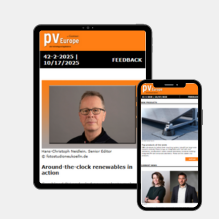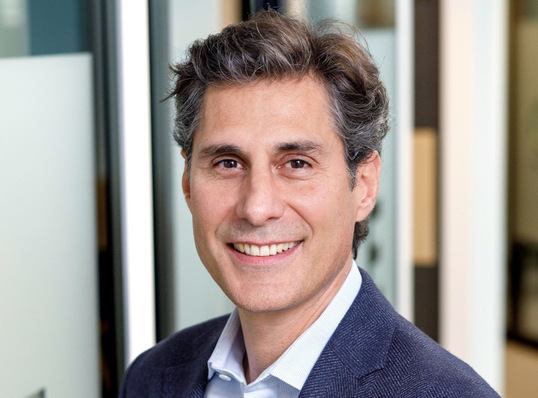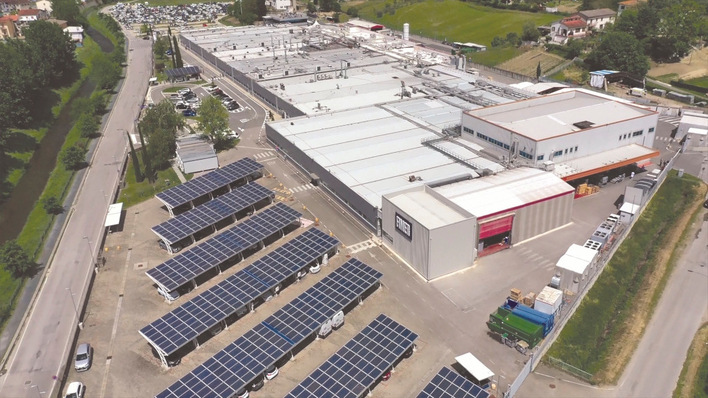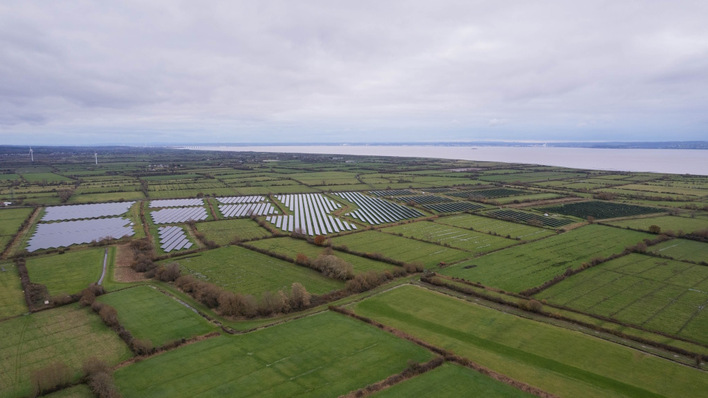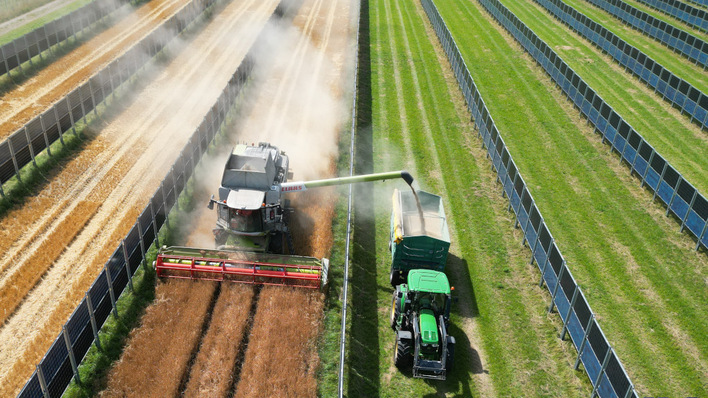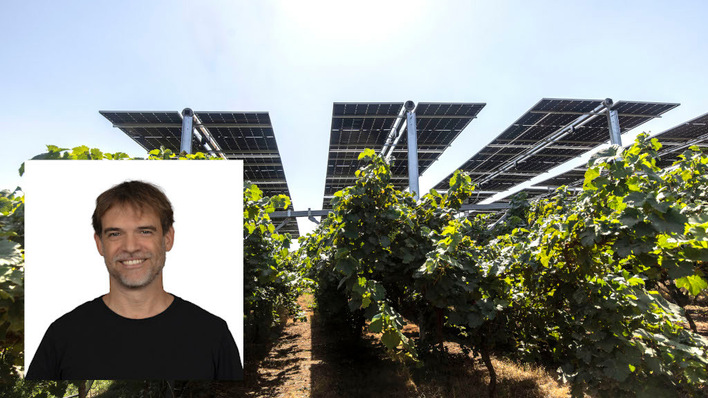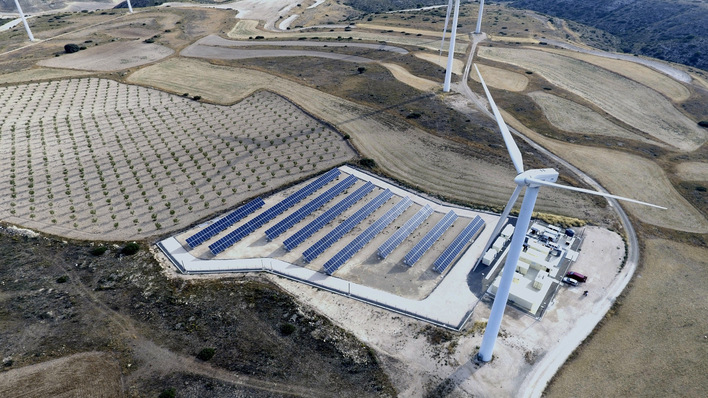Mr. Bovenschen, what exactly do you mean by agrivoltaics?
“Agri-photovoltaics” refers to the combination of energy generation and agriculture on a common area. Agricultural use can involve both crops and livestock farming. The PV modules are then either mounted much higher above the ground so that farming can be carried out below. Or the row spacing is increased and the agricultural activities take place primarily between the rows of modules. Alternatively, the modules can also be installed vertically and farming can also take place between the rows of modules. However, this variant is not currently being subsidised.
We would like to see so-called “external agri-PV” integrated into this segment in , so that it can be considered as particularly eligible for funding. By this we mean ground-mounted photovoltaic systems with wide row spacing in conjunction with grassland management. Grassland management is already a recognized form of agriculture, for example for the production of fodder. Grassland status is important for biodiversity, as grassland provides a high-quality habitat for a large number of different animal and plant species. This should therefore also be recognized as “Agri-PV”.
What opportunities does the Agri-PV offer from your perspective – nationally and internationally?
Agri-PV offers open space potential, especially in densely populated countries with few agricultural areas (e.g. Japan), but also in individual regions with a strong agricultural character (e.g. in northern Italy, in many regions of the Netherlands or in North Rhine-Westphalia). Italy in particular is certainly a pioneer here. There, for example, 1.7 billion euros have been made available to promote more than 1 GW of agri-PV with commissioning by the end of 2026. We are also already very active there.
Read more: Dual use of land: New special on Agri-PV
In general, in addition to the combination with agricultural crops, dual use with livestock farming in particular offers great potential. There is already very good experience in many places with sheep farming under or between the rows of modules. Interestingly, a new DIN specification for agri-PV with animal husbandry is currently being worked on. We expect the results in the coming year; the specifications with regard to animal species groups, stocking density, animal requirements etc. will be decisive.
Nevertheless, it must be emphasized: Agri-PV applications are a useful addition in various niches. However, there is sufficient open space available in Germany for broad-based electricity generation in order to produce cost-effective electricity. The advantage of “agri-PV” would be an opening up of the area, e.g. priority areas for agriculture, as well as a fairly high level of acceptance among the population.
Can it replace “classic" solar parks?
At present, agri-PV is not expected to replace traditional solar parks. Due to the available space, PV systems on open spaces make perfect sense, especially for climate and nature conservation. Biodiversity PV systems – which is what most ground-mounted PV systems are – make a major contribution to nature conservation. At the same time, they are currently the cheapest form of electricity generation. And we don't want to lose sight of that either: a low-cost electricity supply in Germany.
We have also noticed that our customers have so far not specifically requested projects with “Agri-PV” due to their low profitability. Only in a few exceptional cases do we see that “agri-PV” is already economically feasible today, for example in conjunction with a wind project with high soil quality and a nearby grid feed-in point.
In general, however, the aim is actually to replace conventional electricity sources in the medium term with the wide range of renewable energy options, wherever this is possible and sensible. This certainly includes both “classic” solar parks and agri-PV systems.
What about the economic viability of agrivoltaics? Do we need additional subsidies at least for the foreseeable future?
Agri-PV in the form of crops is currently largely uneconomical. The extra remuneration via the technology bonus under the Renewable Energy Sources Act is not enough.
Optimisation brings more yields
Elevated systems (at a clear height of 2.1 m or more) are uneconomical due to the additional costs for the complex racks. Projects elevated vertically are usually uneconomical due to the lower power generation. In order to help agri-PV achieve a market breakthrough and create confidence on the part of banks and investors, higher subsidies and reliable framework conditions such as those in Italy would be helpful.
What effect is the current fall in PV module prices having on the agri-PV sector?
The oversupply of PV modules from Asia is of course also noticeable in this segment. At the same time, however, there are also significant cost increases in other areas, e.g. services (expert opinions, construction work, etc.), racks (a cost driver for agrivoltaics), electrotechnical components (e.g. inverters, control technology) and, very significantly, transformer stations, but also the generally higher level of interest rates. All in all, we have to conclude that The fall in module prices does not compensate for the additional costs, particularly for racks.
Where do you still see a need for development in agri-PV?
A clear definition of agri-PV is necessary, because a clear definition reduces uncertainty in the business model and helps all parties involved (approval authorities, investors, owners, developers, etc.). An adjustment of the EEG subsidy level for crop-based Agri-PV could make these systems more economical and therefore more attractive for investors. If there is a larger market for “Agri-PV”, there will also be more competition for special Agri-PV components, which could lead to cost reductions.
To what extent is Juwi involved in the agri-PV sector, and in which projects?
We are currently heavily involved in the development of projects in Italy in the form of a tracking system (economical due to high irradiation values). We are also planning the first pilot systems as part of research projects in Germany.
Interview by Hans-Christoph Neidlein



